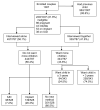Fertility goal-based counseling increases contraceptive implant and IUD use in HIV-discordant couples in Rwanda and Zambia
- PMID: 23153896
- PMCID: PMC3625675
- DOI: 10.1016/j.contraception.2012.10.004
Fertility goal-based counseling increases contraceptive implant and IUD use in HIV-discordant couples in Rwanda and Zambia
Abstract
Background: HIV-discordant heterosexual couples are faced with the dual challenge of preventing sexual HIV transmission and unplanned pregnancies with the attendant risk of perinatal HIV transmission. Our aim was to examine uptake of two long-acting reversible contraceptive (LARC) methods--intrauterine devices (IUD) and hormonal implants--among HIV-discordant couples in Rwanda and Zambia.
Study design: Women were interviewed alone or with their partner during routine cohort study follow-up visits to ascertain fertility goals; those not pregnant, not infertile, not already using LARC, and wishing to limit or delay fertility for ≥3 years were counseled on LARC methods and offered an IUD or implant on-site.
Results: Among 409 fertile HIV-discordant Rwandan women interviewed (126 alone, 283 with partners), 365 (89%) were counseled about LARC methods, and 130 (36%) adopted a method (100 implant, 30 IUD). Of 787 fertile Zambian women interviewed (457 alone, 330 with partners), 528 (67%) received LARC counseling, of whom 177 (34%) adopted a method (139 implant, 38 IUD). In both countries, a woman's younger age was predictive of LARC uptake. LARC users reported fewer episodes of unprotected sex than couples using only condoms.
Conclusions: Integrated fertility goal-based family planning counseling and access to LARC methods with reinforcement of dual-method use prompted uptake of IUDs and implants and reduced unprotected sex among HIV-discordant couples in two African capital cities.
Copyright © 2013 Elsevier Inc. All rights reserved.
Figures
Similar articles
-
Fertility intentions and long-acting reversible contraceptive use among HIV-negative single mothers in Zambia.Am J Obstet Gynecol. 2020 Apr;222(4S):S917.e1-S917.e15. doi: 10.1016/j.ajog.2019.12.269. Epub 2020 Jan 14. Am J Obstet Gynecol. 2020. PMID: 31953114 Free PMC article.
-
Uptake of long acting reversible contraception following integrated couples HIV and fertility goal-based family planning counselling in Catholic and non-Catholic, urban and rural government health centers in Kigali, Rwanda.Reprod Health. 2020 Aug 17;17(1):126. doi: 10.1186/s12978-020-00981-0. Reprod Health. 2020. PMID: 32807177 Free PMC article.
-
Motivational interviewing to promote long-acting reversible contraception among Rwandan couples wishing to prevent or delay pregnancy.Am J Obstet Gynecol. 2020 Apr;222(4S):S919.e1-S919.e12. doi: 10.1016/j.ajog.2019.11.1280. Epub 2019 Dec 12. Am J Obstet Gynecol. 2020. PMID: 31838122 Free PMC article.
-
Canadian Contraception Consensus (Part 1 of 4).J Obstet Gynaecol Can. 2015 Oct;37(10):936-42. doi: 10.1016/s1701-2163(16)30033-0. J Obstet Gynaecol Can. 2015. PMID: 26606712 English, French.
-
[Current status of the female condom in Africa].Sante. 1997 Nov-Dec;7(6):405-15. Sante. 1997. PMID: 9503499 Review. French.
Cited by
-
Cost-effectiveness of integrated HIV prevention and family planning services for Zambian couples.AIDS. 2020 Sep 1;34(11):1633-1642. doi: 10.1097/QAD.0000000000002584. AIDS. 2020. PMID: 32701577 Free PMC article.
-
Optimizing Prevention of HIV and Unplanned Pregnancy in Discordant African Couples.J Womens Health (Larchmt). 2017 Aug;26(8):900-910. doi: 10.1089/jwh.2016.6169. J Womens Health (Larchmt). 2017. PMID: 28829720 Free PMC article.
-
Fertility intentions and long-acting reversible contraceptive use among HIV-negative single mothers in Zambia.Am J Obstet Gynecol. 2020 Apr;222(4S):S917.e1-S917.e15. doi: 10.1016/j.ajog.2019.12.269. Epub 2020 Jan 14. Am J Obstet Gynecol. 2020. PMID: 31953114 Free PMC article.
-
Fertility intentions and contraceptive practices among clinic-users living with HIV in Kenya: a mixed methods study.BMC Public Health. 2017 Jul 5;17(1):626. doi: 10.1186/s12889-017-4514-2. BMC Public Health. 2017. PMID: 28679389 Free PMC article.
-
Single Mothers and Female Sex Workers in Zambia Have Similar Risk Profiles.AIDS Res Hum Retroviruses. 2019 Sep;35(9):814-825. doi: 10.1089/AID.2019.0013. Epub 2019 Jul 30. AIDS Res Hum Retroviruses. 2019. PMID: 31204869 Free PMC article.
References
-
- Joint United Nations Programme on HIV/AIDS (UNAIDS) and World Health Organization (WHO) AIDS Epidemic Update. Geneva, Switzerland: 2009.
-
- UNFPA . State of the World Population 2011. UNFPA; New York, New York:
-
- Centers for Disease Control and Prevention . Family Planning Methods and Practice: Africa. Atlanta, Georgia: 2000.
-
- Iliyasu Z, Abubakar IS, Kabir M, et al. Correlates of fertility intentions among HIV/AIDS patients in northern Nigeria. Afr J Reprod Health. 2009;13:71–83. Epub 2010/08/10. - PubMed
Publication types
MeSH terms
Substances
Grants and funding
LinkOut - more resources
Full Text Sources
Other Literature Sources
Medical



